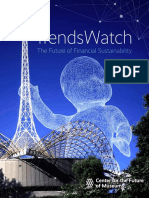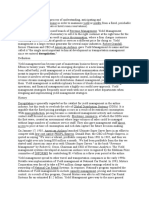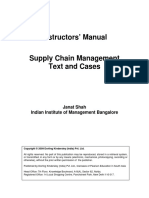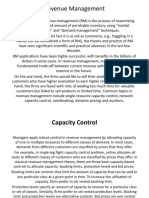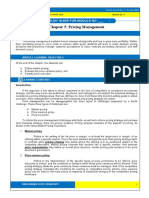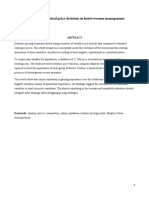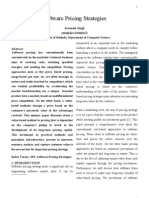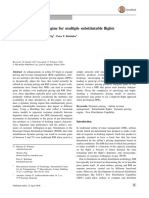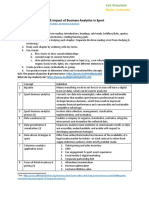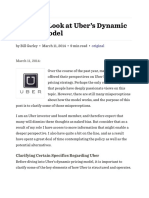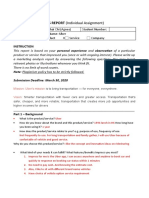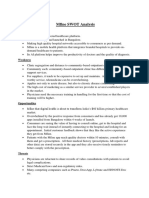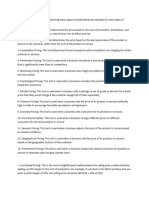A Study On Dynamic Pricing in The Airline Industry Using Reinforcement Learning Analyzing The Impact of Reinforcement Learning On Airline Pricing Strategies
A Study On Dynamic Pricing in The Airline Industry Using Reinforcement Learning Analyzing The Impact of Reinforcement Learning On Airline Pricing Strategies
Volume 9, Issue 11, November – 2024 International Journal of Innovative Science and Research Technology
ISSN No:-2456-2165 https://doi.org/10.38124/ijisrt/IJISRT24NOV671
A Study on Dynamic Pricing in the Airline Industry
Using Reinforcement Learning Analyzing the
Impact of Reinforcement Learning on Airline
Pricing Strategies
Aniket Gursale
Department of Information Technology
Shah & Anchor Kutchhi Engineering College
Mumbai, India
Abstract:- Dynamic pricing serves as an essential tactic in Reinforcement Learning (RL), a sector of machine
the airline sector, allowing airlines to modify ticket rates learning, provides a promising method for dynamic pricing. In
in response to changing market demand, rivalry, and contrast to conventional rule-based systems, RL allows
various other influencing elements. This research models to make sequential choices through interactions with
investigates the use of Reinforcement Learning (RL) in their environment, gradually learning to enhance outcomes
dynamic pricing strategies, emphasizing its ability to over time. Within the realm of airline pricing, RL can
boost revenue management and increase customer perpetually adapt based on elements like booking time, seat
satisfaction. In contrast to conventional pricing strategies, availability, and rival pricing to modify ticket costs
RL allows airlines to adjust prices in real-time by instantaneously, with the goal of optimizing revenue while
continuously analyzing environmental data such as seat satisfying demand and ensuring customer contentment.
availability, departure time, and competitor pricing. This
study explores current pricing models, the framework of This research explores the application of RL in dynamic
RL-driven dynamic pricing, and a case analysis to pricing within the airline sector, emphasizing its capability to
showcase the real-world advantages and difficulties of surpass conventional pricing methods. This research
RL. Core discoveries reveal that RL-driven dynamic investigates how airlines can enhance ticket pricing using RL
pricing provides considerable benefits in responding to by representing dynamic pricing as a Markov Decision
real-time demand fluctuations, thereby optimizing Process (MDP), where states, actions, and rewards are
revenue opportunities. Nonetheless, obstacles like limited modeled to consistently adjust to fluctuating market
data, high computational demands, and striking a balance conditions. The article additionally includes a case study
between exploration and exploitation still persist. The illustrating the success of RL in boosting revenue and
research ends with observations on how RL can further improving customer-focused pricing.
reshape airline revenue management and suggests future
research avenues to improve its practical uses. II. LITERATURE REVIEW
Keywords:- Dynamic Pricing, Reinforcement Learning, A. Traditional Pricing Models in the Airline Industry
Airline Revenue Management, Machine Learning, The airline sector has historically employed static
Optimization, Predictive Models, Customer Demand. pricing and market division. Fixed pricing provides minimal
flexibility, since costs are usually determined by a few general
I. INTRODUCTION factors such as the time of reservation or the type of customer
(e.g., business or leisure traveler). Segmentation strategies
The airline industry is recognized for its intricate assign varied prices for designated customer segments but do
revenue management tactics, where enhancing ticket prices is not have real-time flexibility.
crucial for increasing profitability and addressing varying
demand. Conventional pricing models, like fixed pricing and Yield Management enhances these models by modifying
segmentation, enable airlines to classify customers and inventory distribution and pricing according to predicted
modify prices according to overall demand patterns, yet they demand. Yield management leverages past data to predict
lack adaptability to quickly shifting market conditions. times of increased demand, like holidays or weekends,
Dynamic pricing, which modifies ticket costs in real-time enabling airlines to increase fares during busy periods. While
according to multiple factors, has become a more efficient yield management effectively increases revenue to some
way to manage the fluctuating nature of airline demand. degree, it lacks the dynamic, real-time adjustments required
Nonetheless, executing efficient dynamic pricing necessitates for a market that is becoming more unpredictable.
advanced strategies that can learn from and adjust to
continuously changing market circumstances.
IJISRT24NOV671 www.ijisrt.com 895
Volume 9, Issue 11, November – 2024 International Journal of Innovative Science and Research Technology
ISSN No:-2456-2165 https://doi.org/10.38124/ijisrt/IJISRT24NOV671
B. Machine Learning in Dynamic Pricing Actions (A):
Machine learning has played a major role in enhancing Actions signify various pricing choices. For every state,
demand forecasting and pricing predictions. Regression the RL agent has various pricing options (such as raising
models forecast customer demand and sales patterns by price, lowering price, or keeping the price unchanged),
considering aspects such as seasonal variations, competitor enabling it to understand the effects of each pricing decision
activities, and consumer behavior. Supervised learning on revenue.
methods, such as regression and classification, can recognize
patterns in past data and help in establishing price levels. Rewards (R):
The reward function encourages the RL agent to enhance
Nonetheless, these techniques are primarily static since revenue by finding a balance between the volume of ticket
they function based on existing data patterns without any real- sales and the pricing of tickets. Every action result in a reward
time learning. This restriction presents a chance for tied to the revenue produced, with modifications for empty
Reinforcement Learning, which can adjust in real-time seats and timing (approaching departure heightens urgency).
according to the changing market conditions.
Policy (π):
C. Reinforcement Learning for Dynamic Pricing The policy specifies the strategy of the RL agent,
RL shows significant potential for dynamic pricing in associating states with actions that optimize cumulative
contexts where rapid decision-making and flexibility are rewards. As time progresses, the agent improves its policy by
essential. In RL, an agent (the pricing model) acquires the analyzing the results of past actions, advancing toward the
ability to make choices that enhance rewards (revenue) best pricing strategy.
through interaction with its environment (the market). The
RL agent learns consistently from its actions, adjusting its In this MDP framework, the objective of the RL agent is
approach based on feedback received for every pricing to enhance total rewards throughout a series of actions,
choice. RL applications in e-commerce, digital advertising, adjusting its approach to fine-tune pricing in response to state
and ride-hailing have demonstrated enhanced effectiveness in variations, customer needs, and competitive dynamics.
adjusting to changing demand, providing valuable insights
regarding its possibilities for the airline sector. B. Key RL Algorithms for Dynamic Pricing
Various RL algorithms are utilized in dynamic pricing to
III. REINFORCEMENT LEARNING IN DYNAMIC manage the intricacies of real-time decision-making. Every
PRICING algorithm provides distinct advantages and can be utilized
according to particular problem needs.
Reinforcement Learning (RL) is especially ideal for
dynamic pricing because of its ability to learn continuously, Q-Learning:
make decisions in uncertain situations, and adjust to changes. Q-learning is an algorithm without a model, wherein the
In dynamic pricing, RL facilitates the creation of pricing agent develops an action-value function (Q-value) that
strategies that weigh short-term profit against long-term approximates the anticipated reward for every state-action
revenue growth. The airline sector, characterized by combination. Q-learning enables the agent to develop
fluctuating demand trends, is a perfect environment for RL- effective pricing strategies gradually without requiring an
driven models capable of modifying ticket prices using real- environment model. Despite its strength, Q-learning's
time information. This section offers a thorough analysis of performance might diminish in high-dimensional state spaces
the application of RL in dynamic pricing, detailing the pricing without adjustments, and this is where deep learning can
issue framed as a Markov Decision Process (MDP), vital RL improve it.
algorithms utilized in dynamic pricing, the idea of exploration
versus exploitation, and aspects to consider for real-time Deep Q-Networks (DQN):
deployment. DQN integrates Q-learning with deep neural networks to
approximate the Q-value function for high-dimensional pairs
A. Formulating Dynamic Pricing as a Markov Decision of states and actions. DQN is especially beneficial in dynamic
Process (MDP) pricing scenarios where the state space is extensive (for
In RL, dynamic pricing can be represented as an MDP, a instance, considering customer traits, seasonal demand
structure employed to illustrate decision-making issues where variations, and competitor pricing strategies). DQN can
results are partly stochastic and reliant on the agent’s choices. understand intricate relationships and dependencies, allowing
The MDP framework is made up of: for more refined pricing choices that take into account a wider
array of factors.
States (S):
Every state symbolizes the existing market and Double Q-Learning:
reservation circumstances, including demand intensity, seat Double Q-learning tackles the overestimation bias found
availability, days left until departure, time of day, and pricing in Q-learning by employing two value functions for Q-value
from competitors. This multi-faceted state space encompasses updates, resulting in more stable learning. This method can
different market dynamics and enables the model to react aid dynamic pricing by minimizing the chance of establishing
according to real-time data. excessively high prices, thereby improving the strength of the
pricing model.
IJISRT24NOV671 www.ijisrt.com 896
Volume 9, Issue 11, November – 2024 International Journal of Innovative Science and Research Technology
ISSN No:-2456-2165 https://doi.org/10.38124/ijisrt/IJISRT24NOV671
Policy Gradient Techniques: demand routes, and assist in generalizing models across
Rather than estimating action-value pairs, policy various market segments.
gradient techniques directly enhance the policy by modifying
parameters to increase the anticipated reward. These E. Real-Time Deployment of RL Models in Pricing Systems
techniques are especially beneficial for continuous action Implementing RL models in real-time necessitates
spaces, which can be relevant when establishing flexible, computational efficiency as well as compatibility with airline
detailed pricing points. Actor-Critic and Proximal Policy revenue management systems. Factors to take into account
Optimization (PPO) are well-known policy gradient methods are:
that enable immediate modifications to the pricing strategy.
Latency Requirements:
Multi-Agent RL (MARL): Rapid decisions on dynamic pricing are essential to
In competitive airline markets, a multi-agent system align with current market conditions. A cloud-based
could model interactions between various airlines, each framework can manage large data quantities and analyze RL
depicted by an RL agent that modifies prices according to the model results almost instantly.
actions of others. MARL can assist in grasping competitive
interactions and enhancing pricing strategies. Scalability:
Airlines need to guarantee the RL model can expand to
C. Exploration vs. Exploitation in Dynamic Pricing meet changing demand, necessitating powerful servers,
A major difficulty in RL is the balance between streamlined code, and effective model design.
exploration (testing new pricing methods) and exploitation
(utilizing established profitable methods). In flexible pricing: Safety Measures:
Instant deployment might involve safety features like
Investigation is crucial for uncovering innovative pricing price limits or thresholds to avoid severe price fluctuations
methods that could generate increased revenues in that could harm brand image or customer confidence.
specific market situations. For example, in off-peak
periods or among certain customer groups, research can Real-time reinforcement learning applications in pricing
uncover ideal prices that may otherwise go unnoticed. systems provide a competitive edge by facilitating constant
Exploitation centers on utilizing the most lucrative updates to pricing strategies based on evolving demand,
recognized approach derived from past data and acquired competitor behavior, and external influences (such as
experiences. During high travel periods, leveraging tactics economic events and weather changes).
can guarantee that prices are optimized to enhance
revenue according to past effective methods. IV. CASE STUDY: RL-BASED DYNAMIC PRICING
MODEL IN THE AIRLINE INDUSTRY
It is essential to balance these methods. Epsilon-Greedy
Decay and Upper Confidence Bound (UCB) are well-known A. Data Collection
exploration strategies employed in dynamic pricing to Data for training the RL model includes:
dynamically modify exploration rates according to market
fluctuations and time constraints. Epsilon-Greedy begins with Historical Ticket Sales:
a significant exploration rate that gradually decreases, Previous sales and pricing information are essential for
whereas UCB applies confidence intervals to actions, recognizing trends in customer demand.
prioritizing exploration of those with high potential.
Competitive Pricing:
D. Advanced Techniques in RL for Dynamic Pricing Pricing strategies of competitors enable the RL model to
In airline dynamic pricing, various advanced adapt prices according to market placement.
reinforcement learning methods improve efficiency:
External Factors:
Reward Shaping: Economic metrics, like oil prices and seasonal
Tailoring the reward function to motivate desired occurrences, guide the RL model regarding wider impacts on
results, like preventing price undercutting against competitors demand.
or increasing long-term customer loyalty.
B. Model Implementation
Hierarchical RL: The RL model denotes states (such as seat occupancy,
Utilizing hierarchical RL frameworks in which sub- booking window, competitor prices) and actions (pricing
agents manage particular elements (e.g., weekday rates changes), with rewards determined by the revenue produced.
versus weekend rates), developing a detailed, multi-level The model functions by examining pricing tactics and
pricing structure. utilizing those that produce greater revenue.
Transfer Learning: Through the simulation of demand trends, the RL model
Utilizing insights acquired from pricing on one route to acquires the ability to recognize ideal pricing strategies,
benefit other comparable routes. Transfer learning can harmonizing competitive pricing with profitability.
accelerate training, minimize data requirements on low-
IJISRT24NOV671 www.ijisrt.com 897
Volume 9, Issue 11, November – 2024 International Journal of Innovative Science and Research Technology
ISSN No:-2456-2165 https://doi.org/10.38124/ijisrt/IJISRT24NOV671
C. Results REFERENCES
The dynamic pricing model based on RL resulted in
substantial revenue growth, surpassing conventional pricing [1.] Zhang, C., & Zheng, X. (2023). Dynamic Pricing for
methods by adjusting to live demand. The model effectively Airline Tickets Using Reinforcement Learning. Springer.
modified prices in real-time, boosting seat occupancy and [2.] Li, X., & Zhang, H. (2022). A Study on Dynamic
total revenue. The model showed flexibility when faced with Pricing Models in the Airline Industry. ScienceDirect.
abrupt shifts in demand, showcasing its efficacy in an [3.] Gupta, V., & Choudhury, P. (2023). Reinforcement
unpredictable market. Learning for Dynamic Pricing in Airline Revenue
Management. IEEE.
V. CHALLENGES IN RL FOR DYNAMIC PRICING [4.] Sharma, N., & Kapoor, P. (2023). Dynamic Pricing for
Airlines: A Reinforcement Learning Approach. Elsevier.
Despite RL’s potential, there are significant challenges [5.] Kumar, A., & Dey, S. (2021). Deep Reinforcement
in applying it to airline pricing: Learning for Airline Revenue Optimization. Springer.
[6.] Singh, A., & Tiwari, R. (2022). Pricing Optimization in
A. Data Scarcity and Quality Airlines Using Reinforcement Learning Algorithms.
Effective RL training relies on large datasets. In ResearchGate.
markets with low demand or on new routes, a lack of data [7.] Yadav, R., & Jain, V. (2024). RL-Based Dynamic
may restrict model effectiveness. Synthetic data creation and Pricing Mechanism for Airline Industry. Wiley.
data enhancement are viable solutions that allow for the [8.] Park, J., & Lee, D. (2023). Competitive Pricing in
production of simulated data for infrequent or low-traffic Airline Markets with Reinforcement Learning. Taylor &
routes. Francis.
[9.] Saha, D., & Mishra, B. (2021). Reinforcement Learning
B. Exploration vs. Exploitation for Dynamic Pricing in Competitive Markets. IEEE
RL models need to find a balance between exploration Transactions.
(trying out new approaches) and exploitation (utilizing [10.] Nissenbaum, A., & Gollapudi, R. (2021). Can
established effective strategies). Although exploration is Dynamic Pricing Algorithm Facilitate Tacit Collusion
essential for finding the best pricing, too much exploration in Airline Markets? American Economic Association
may lead to lost income or reduced customer loyalty. (AEA).
Adaptive exploration methods, like epsilon-greedy decay or
UCB (Upper Confidence Bound), can assist in handling this
balance more efficiently.
C. Real-Time Computational Requirements
Deploying real-time RL necessitates significant
computational resources. Effective integration with airline
reservation and revenue management systems is essential for
prompt decision-making. Cloud-based solutions and
distributed computing could assist in meeting computational
needs, enabling quicker and more effective processing.
VI. CONCLUSION AND FUTURE DIRECTIONS
Reinforcement Learning offers an effective method for
dynamic pricing in the airline sector, merging real-time
flexibility with analytics-based enhancement. RL models
surpass conventional techniques by dynamically altering
prices according to real-time market information, enabling
airlines to stay competitive in changing markets.
Future studies might investigate multi-agent RL, in
which several agents (representing various airlines) engage to
model a competitive marketplace. This method might provide
understanding of strategic pricing in a competitive
environment. Furthermore, transfer learning may enhance
generalization across markets, enabling RL models to swiftly
adjust to new routes or customer segments. Tackling issues
related to data quality, computational efficiency, and
ensuring a balance between exploration and exploitation is
essential for improving RL in airline revenue management.
IJISRT24NOV671 www.ijisrt.com 898
You might also like
- Trendswatch: The Future of Financial SustainabilityNo ratings yetTrendswatch: The Future of Financial Sustainability52 pages
- Dynamic Retail Pricing via Q-Learning Nov 2024No ratings yetDynamic Retail Pricing via Q-Learning Nov 20244 pages
- Name-Nanda Kishore Division - D ROLL NO - 4744: Cost-Based PricingNo ratings yetName-Nanda Kishore Division - D ROLL NO - 4744: Cost-Based Pricing4 pages
- A Systematic Requirement Analysis For Dynamic Pricing in Retail E-CommerceNo ratings yetA Systematic Requirement Analysis For Dynamic Pricing in Retail E-Commerce7 pages
- Railways Tender Price Prediction Using Machine Learning and Deep Learning AlgorithmsNo ratings yetRailways Tender Price Prediction Using Machine Learning and Deep Learning Algorithms8 pages
- Airline Revenue Management Hand Out Notes One100% (1)Airline Revenue Management Hand Out Notes One30 pages
- Pricing and Revenue Optimization, Defined As The Formulation and Solution of Tactical PricingNo ratings yetPricing and Revenue Optimization, Defined As The Formulation and Solution of Tactical Pricing3 pages
- Yield Management: Resolving Potential Customer and Employee ConflictsNo ratings yetYield Management: Resolving Potential Customer and Employee Conflicts33 pages
- Yield Management Is The Process of Understanding, Anticipating andNo ratings yetYield Management Is The Process of Understanding, Anticipating and7 pages
- Instructors' Manual: Janat Shah Indian Institute of Management BangaloreNo ratings yetInstructors' Manual: Janat Shah Indian Institute of Management Bangalore9 pages
- Developing Service Product: Setting Prices and Implementing Revenue ManagementNo ratings yetDeveloping Service Product: Setting Prices and Implementing Revenue Management7 pages
- Analysis of Machine Learning Model For Predicting Sales ForecastingNo ratings yetAnalysis of Machine Learning Model For Predicting Sales Forecasting6 pages
- Dynamic Pricing Model of E-Commerce Platforms BaseNo ratings yetDynamic Pricing Model of E-Commerce Platforms Base17 pages
- Effect of Pricing Strategy on Customer Retention in KurdistanNo ratings yetEffect of Pricing Strategy on Customer Retention in Kurdistan15 pages
- An Improved Stock Price Prediction Using Ensemble Regression ModelNo ratings yetAn Improved Stock Price Prediction Using Ensemble Regression Model16 pages
- BCG Pricing Fluency Dec 2009 tcm80-35619 PDFNo ratings yetBCG Pricing Fluency Dec 2009 tcm80-35619 PDF4 pages
- Yield Management Pricing - Group 7 ReportNo ratings yetYield Management Pricing - Group 7 Report4 pages
- WNS WP Dynamics of Emerging Pricing Models in Business Process ManagementNo ratings yetWNS WP Dynamics of Emerging Pricing Models in Business Process Management8 pages
- ANALYTICS IN PRICING AND REVENUE MANAGEMENTNo ratings yetANALYTICS IN PRICING AND REVENUE MANAGEMENT4 pages
- AMR Research REPORT 17125 - AMR Researchs Price Management ModelNo ratings yetAMR Research REPORT 17125 - AMR Researchs Price Management Model8 pages
- Customer Classification by Past Purchase Data AnalysisNo ratings yetCustomer Classification by Past Purchase Data Analysis4 pages
- Strategic and Tactical Price Decisions in Hotel Revenue ManagementNo ratings yetStrategic and Tactical Price Decisions in Hotel Revenue Management24 pages
- EduTech Portal: An AI-Powered Student Assistant ChatbotNo ratings yetEduTech Portal: An AI-Powered Student Assistant Chatbot12 pages
- Design and Implementation of a GPS-GSM based Real-Time Vehicle Theft Tracking System for Urban Security in UgandaNo ratings yetDesign and Implementation of a GPS-GSM based Real-Time Vehicle Theft Tracking System for Urban Security in Uganda7 pages
- Enhancing the Robustness of Computer Vision Models to Adversarial Perturbations Using Multi-Scale Attention MechanismsNo ratings yetEnhancing the Robustness of Computer Vision Models to Adversarial Perturbations Using Multi-Scale Attention Mechanisms14 pages
- Development of Mirror Biosensor in Saliva pH Measurement in Health ServicesNo ratings yetDevelopment of Mirror Biosensor in Saliva pH Measurement in Health Services7 pages
- Architecture as a Reflection of Cultural Continuity: A Study of Traditional TrendsNo ratings yetArchitecture as a Reflection of Cultural Continuity: A Study of Traditional Trends3 pages
- Analysis of the Export Competitiveness of Indonesia's Horticultural Fruit Products in the International MarketNo ratings yetAnalysis of the Export Competitiveness of Indonesia's Horticultural Fruit Products in the International Market8 pages
- ResumeMatch: Intelligent Resume Enhancement & Job Fit AnalysisNo ratings yetResumeMatch: Intelligent Resume Enhancement & Job Fit Analysis7 pages
- Behavior Addiction in Adolescents Post COVID 19: A Systematic Mental Health ReviewNo ratings yetBehavior Addiction in Adolescents Post COVID 19: A Systematic Mental Health Review8 pages
- Evaluating the Impact of Shopee Mall on Consumer Purchase: Basis for Developing an Effective Marketing PlanNo ratings yetEvaluating the Impact of Shopee Mall on Consumer Purchase: Basis for Developing an Effective Marketing Plan61 pages
- Machine Learning for Predictive Analytics: Trends and Future DirectionsNo ratings yetMachine Learning for Predictive Analytics: Trends and Future Directions8 pages
- A Decade of Genome Editing: Comparative Review of Zfn, Talen, and Crispr/Cas9No ratings yetA Decade of Genome Editing: Comparative Review of Zfn, Talen, and Crispr/Cas910 pages
- Automating Meeting Management: An AI-Driven Web-Based Meeting Management SystemNo ratings yetAutomating Meeting Management: An AI-Driven Web-Based Meeting Management System7 pages
- Advances and Challenges in Regenerative Medicine: A Comprehensive Review100% (1)Advances and Challenges in Regenerative Medicine: A Comprehensive Review17 pages
- The Role of Nutrition in Menstrual Cycle Regularity and the Management of Menstrual Disorder: A ReviewNo ratings yetThe Role of Nutrition in Menstrual Cycle Regularity and the Management of Menstrual Disorder: A Review5 pages
- Design and Development of a Micro Drone to Enhance Rescue Missions in Fire-Affected ZonesNo ratings yetDesign and Development of a Micro Drone to Enhance Rescue Missions in Fire-Affected Zones7 pages
- Infrastructure and Sustainable Growth in Nigeria: A Multi-Sectoral Analysis of Development Indicators and their Long-Run Impact (1999–2022)No ratings yetInfrastructure and Sustainable Growth in Nigeria: A Multi-Sectoral Analysis of Development Indicators and their Long-Run Impact (1999–2022)13 pages
- The Therapeutic Potential and Ethical Implications of Medical Cannabis in Parkinson's Disease: Exploring Mitigation of Reliance on Deep Brain StimulationNo ratings yetThe Therapeutic Potential and Ethical Implications of Medical Cannabis in Parkinson's Disease: Exploring Mitigation of Reliance on Deep Brain Stimulation4 pages
- Safeguarding Lives with Electrical Safety PracticesNo ratings yetSafeguarding Lives with Electrical Safety Practices5 pages
- Improved Maximum Power Point Tracking in Photovoltaic Systems via Fuzzy Backstepping Sliding Mode Control and PSO OptimizationNo ratings yetImproved Maximum Power Point Tracking in Photovoltaic Systems via Fuzzy Backstepping Sliding Mode Control and PSO Optimization11 pages
- Comparative Study of Practical and Theoretical Approach in Teaching and Learning of Chemistry A Case Study of Government Technical College KanoNo ratings yetComparative Study of Practical and Theoretical Approach in Teaching and Learning of Chemistry A Case Study of Government Technical College Kano6 pages
- A Survey on the Identification of Credit Card Fraud Using Machine Learning with Precision, Performance, and ChallengesNo ratings yetA Survey on the Identification of Credit Card Fraud Using Machine Learning with Precision, Performance, and Challenges8 pages
- Songs to Syntax: Exploring Syntactic Features of Selected Original Pilipino MusicNo ratings yetSongs to Syntax: Exploring Syntactic Features of Selected Original Pilipino Music7 pages
- Investment Feasibility of Hydroponic Farming: Analysing the Return on Investment (ROI) Compared to Traditional FarmingNo ratings yetInvestment Feasibility of Hydroponic Farming: Analysing the Return on Investment (ROI) Compared to Traditional Farming4 pages
- Computer-Assisted Lung Cancer Diagnosis through Morphological Analysis & CNNNo ratings yetComputer-Assisted Lung Cancer Diagnosis through Morphological Analysis & CNN7 pages
- Contractor Selection by using Analytical Network Process (ANP)No ratings yetContractor Selection by using Analytical Network Process (ANP)7 pages
- Enhancing Electoral Transparency in Sierra Leone through Data Visualization and MappingNo ratings yetEnhancing Electoral Transparency in Sierra Leone through Data Visualization and Mapping12 pages
- UML Modeling and Full-Stack Implementation of a Teleconsultation Platform with Real-Time Management of Patients and Medical ProceduresNo ratings yetUML Modeling and Full-Stack Implementation of a Teleconsultation Platform with Real-Time Management of Patients and Medical Procedures13 pages
- The Evolution of Luxury Tourism in Thailand: Trends and Consumer Behavior in the Hotel Industry by 2030No ratings yetThe Evolution of Luxury Tourism in Thailand: Trends and Consumer Behavior in the Hotel Industry by 203012 pages
- Effects of Tariffs on Electric ConsumptionNo ratings yetEffects of Tariffs on Electric Consumption6 pages
- Mathematical Optimization of Vertical Farm Locations Advancing Sustainable Agriculture in Saudi ArabiaNo ratings yetMathematical Optimization of Vertical Farm Locations Advancing Sustainable Agriculture in Saudi Arabia26 pages
- Economics Volatility in the Indian Airlines IndustryNo ratings yetEconomics Volatility in the Indian Airlines Industry6 pages
- Sop and Literature With Justification - FinalNo ratings yetSop and Literature With Justification - Final3 pages
- IDeaS RevenueManagementRecipes eBook-Final PDF100% (1)IDeaS RevenueManagementRecipes eBook-Final PDF26 pages
- DDA1730308 Uber Case Study PresentationNo ratings yetDDA1730308 Uber Case Study Presentation12 pages
- Reliance Smart Bazaar Pricing StrategiesNo ratings yetReliance Smart Bazaar Pricing Strategies10 pages
- Chapter 1 Evolution and Impact of Business Analytics in SportNo ratings yetChapter 1 Evolution and Impact of Business Analytics in Sport3 pages
- A Deeper Look at Uber's Dynamic Pricing Model - AbovethecrowdNo ratings yetA Deeper Look at Uber's Dynamic Pricing Model - Abovethecrowd11 pages
- Principles of Marketing Chapter 11 and 12No ratings yetPrinciples of Marketing Chapter 11 and 1234 pages
- Session 5 - UBER, An Empire in The MakingNo ratings yetSession 5 - UBER, An Empire in The Making8 pages
- Rupasree Dey - Uber&mfine - Financial Information & SWOT - PDFNo ratings yetRupasree Dey - Uber&mfine - Financial Information & SWOT - PDF3 pages


